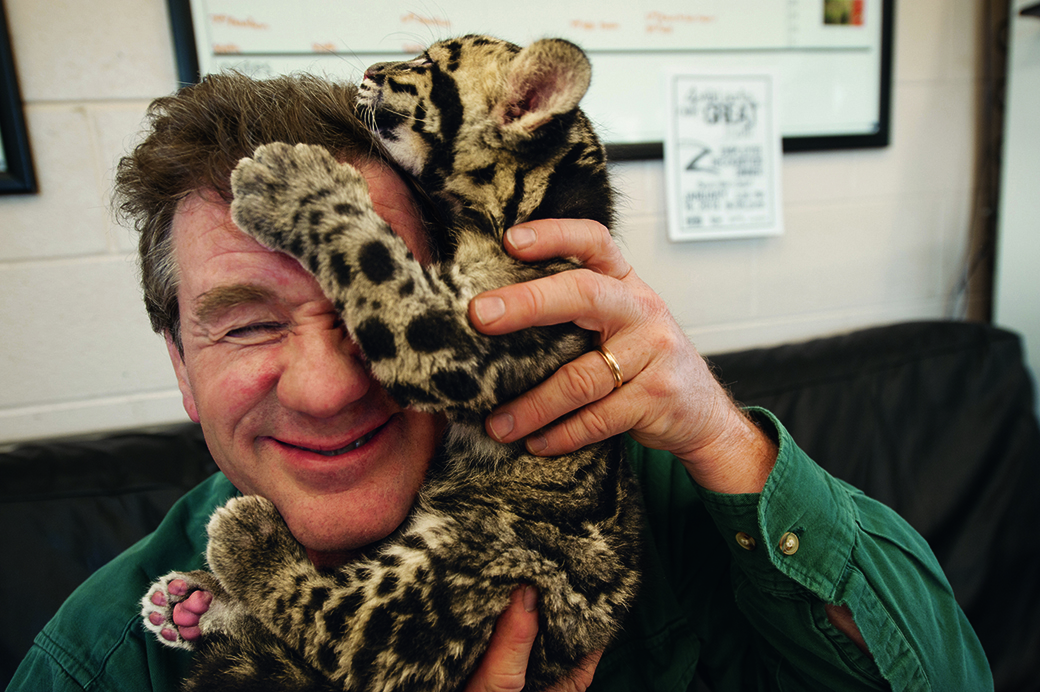
[:en]If Noah had a camera, perhaps he would have done what noted nature and wildlife photographer Joel Sartore is doing. Sartore, who resides in Lincoln, Neb., is a star National Geographic shooter in the midst of an epic project, aptly named Photo Ark, that’s creating an archive of global biodiversity in order to raise awareness and spur acton around endangered habitats and species. The National Geographic Society is throwing its considerable weight behind the effort.
The endeavor transcends geo-political differences to put a face on stressed ecosystems and inhabitants.
Photo Ark grew out of Sartore’s early assignments around the world documenting wildlife.
In addition to National Geographic magazine, he’s shot for Audubon, Life and book projects. His work’s been the subject of national broadcasts. He’s a regular contributor on CBS Sunday Morning.
The more he saw and learned, the more species and habitats that became threatened, the more urgency he felt to create a comprehensive archive in his lifetime.
“I’ve been a National Geographic photographer for more than 27 years, and I photographed the first 15 years or so out in the wild doing different conservation stories, on wolves, on grizzly bears, on koalas, all in the wild,” he said. “Can I say that moved the needle enough to stop the extinction crisis? No, it did not. So I just figured maybe very simple portraits lit exquisitely so you can see the beauty and the color, looking animals directly in the eye with no distractions, would be the way to do it.
“NG sees themselves as not only responsible stewards of the environment, but they’re in it for the long haul. I always believed that, if I could build the project up a bit, they would see the value in it. And they sure have. Sadly, I have seen species go extinct since starting the Photo Ark. A rabbit, a fish, an insect and the Rabbs’ fringe-limbed treefrog have all gone extinct since I photographed them. It saddens me greatly, but also angers and inspires me to want to give everything I’ve got to this project, and use extinction as a wake up call. As these species go away, so could we.”
Traveling to where species are, often to remote areas, accounts for much of his time on the project.
Ironically, the Photo Ark practically began in his own backyard about 12 years ago.
“The Photo Ark started when my wife got breast cancer. That event ‘grounded’ me for a year in that I literally needed to stay home and take care of my wife and kids while she got chemo and radiation. She’s fine now, and on the days that she felt better, I started going to the Lincoln Children’s Zoo, a mile from my house, to take photos. The naked mole rat at the Lincoln Children’s Zoo was the first animal to come on board the Ark.
“Since then, I have visited 40 countries and worked in more than 250 zoos, aquariums and animal rescue centers around the world to create the Photo Ark. Most of the countries I’ve visited for this project are those I’d not visited before.”
He’s already logged thousands of hours and tens of thousands of miles to photograph thousands of species, and yet he’s far from finished.
“We are a little more than halfway done after 12 years with just over 7,500 species (photographed). Because we’ll now have to travel farther and wider to get the remaining species (an estimated 5,000 more), it’ll take us another 15 years to complete. So, if I had to guess, I’d say another 30 countries or so should do it.”
When working in the wild, things can get hairy.
“Now that I’m working mainly at zoos, the work has fewer unpleasant surprises. During my 16 years on assignment in the field for National Geographic magazine, however, I had a few close calls with critters. But it’s mostly the little things I’m most wary of.”
For example, there are diseases carried by insects like the Marburg virus.
“I was quarantined three weeks for that one and didn’t get it.”
Then there’s a flesh-eating parasite called mucocutaneous leishmaniasis.
“I did get that one and the treatment is no fun at all.”
Things are less creepy-crawly today,
“These days, working in controlled environments. most of these shoots go extremely smoothly because the animals have been around people all their lives,” he said. “But sometimes the critters do ‘have their way’ with my backgrounds and sets.
“Having enough time to get to everything is the biggest challenge, but definitely doable. Thankfully, the project isn’t political and so we’re welcomed pretty much everywhere we go.”
The work holds deep personal meaning for him.[:es]Si Noé hubiera tenido una cámara, tal vez él hubiera hecho lo que Joel Sartore, destacado fotógrafo de naturaleza y vida salvaje, está haciendo. Sartore, quien reside en Lincoln, Nebraska, es el fotógrafo estrella para National Geographic que está trabajando sobre un épico proyecto llamado Photo Ark (Arca Fotográfica), mismo con el que está creando un archivo sobre biodiversidad global para poder incrementar la concienciación y las acciones sobre los hábitats y especies en peligro. La National Geographic Society está apoyando este esfuerzo de forma considerable.
El proyecto va más allá de las diferencias geo-políticas para poner un rostro sobre los ecosistemas y sus habitantes.
Photo Ark creció de uno de los proyectos anteriores de Sartore al documentar la vida salvaje por el mundo.
Además de trabajar para la revista National Geographic, él también ha realizado fotografías para Audubon, Life y para libros. Su trabajo ha sido presentado en programas a nivel nacional. Él también contribuye de forma regular a CBS Sunday Morning.
Mientras más veía y aprendía, mientras más especies y hábitats entraban en riesgo, más era la urgencia que sentía de crear un archivo integral durante su vida.
“He sido fotógrafo de National Geographic durante más de 27 años y fotografíe durante los primeros alrededor de 15 años trabajando sobre historias de conservación sobre lobos, sobre osos pardos, koalas, todo en el mundo salvaje”, nos dijo. “¿Puedo decir que eso tuvo un impacto como para detener la crisis de extinción? No, no lo hizo. Así que pensé que tal vez tomar fotografías con una iluminación adecuada que permita apreciar la belleza y el color de cada animal, viéndoles directamente a los ojos sin distracción alguna, sería la forma adecuada de hacerlo. National Geographic se ve a sí misma no solamente como guardianes del ambiente, sino que buscan hacer mucho más a largo plazo. Yo siempre había creído que si yo podía trabajar un poco sobre el proyecto, ellos verían el valor de todo, y vaya que lo han hecho. Por desgracia, desde que comencé con el proyecto del Photo Ark he visto como algunas especies se han extinguido. Un conejo, un pez, un insecto y la rana de árbol Rabbs, todos se han extinguido desde que les fotografíe. Me entristece mucho, pero también me hace enojar y me inspira para darlo todo para trabajar sobre este proyecto y usar su extinción como una gran llamada de atención. Así como desaparecen estas especies, también podríamos desaparecer nosotros”.
Viajar a donde se encuentran estas especies, lugares usualmente en áreas remotas, es lo que toma más de su tiempo en este proyecto. Curiosamente, el Photo Ark comenzó en su propio patio trasero hace alrededor de 12 años.
“El Photo Ark comenzó cuando mi esposa fue diagnosticada con cáncer de seno. Ese evento me llevó a quedarme durante un año en casa y cuidar de mi esposa y mis hijos, mientras mi esposa recibía su tratamiento. Ella ahora está bien, y durante los días en que ella se sentía mejor, yo comencé a ir al Zoológico Lincoln Children, a una milla de distancia de mi casa, para tomar fotografías. La rata topo desnuda del Zoológico Lincoln Children fue el primer animal que ‘subió al arca’. Desde entonces yo he visitado 40 países y trabajado en más de 250 zoológicos, acuarios y centros de rescate de animales alrededor del mundo para crear el Photo Ark. La mayoría de los países que he visitado para este proyecto son países que no había visitado antes”.
Él ya ha acumulado miles de horas y decenas de miles de millas viajando para fotografiar a miles de especies, pero todavía le falta mucho para terminar.
“Después de 12 años de trabajo, el proyecto va a la mitad del camino con poco más de 7,500 especies (fotografiadas). Como ahora tendré que viajar más lejos para poder fotografiar a las especies restantes (un estimado de 5,000 más), nos tomará otros 15 años para completar. Así que, si tuviera que dar un estimado, diría que nos faltan alrededor de 30 países más”.
Cuando trabajas en el mundo salvaje, las cosas pueden ser difíciles.[:]



